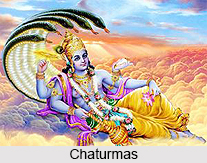 Chaturmas is a sacred era of four months from July to October. Chaturmas begins from Shayani Ekadashi, the eleventh day of the first bright half, Shukla paksha, of Ashadh which is known as the fourth month of the Hindu lunar calendar until Prabodhini Ekadashi, the eleventh day of the first bright half of Kartik.
Chaturmas is a sacred era of four months from July to October. Chaturmas begins from Shayani Ekadashi, the eleventh day of the first bright half, Shukla paksha, of Ashadh which is known as the fourth month of the Hindu lunar calendar until Prabodhini Ekadashi, the eleventh day of the first bright half of Kartik.
Meaning of Chaturmas
Chaturmas literally means "four months", derived from the Sanskrit catur "four" and masa means the "month".
Practise of Chaturmas
Chaturmas is practised among the Hindus, Buddhists and the Jains.
Observation of Chaturmas
Chaturmas is observed for penance, austerities, fasting, bathing in holy rivers and religious observances for all. The Jain, Buddhists and the Hindu devotees resolve to observe some form of vow, be it of silence or abstaining from a favourite food item, or having only a single meal in a day.
Geographical Observation in Chaturmas
The sun enters the zodiacal sign of Cancer and begins to move southwards in the month of Ashadh.
Mythology on Chaturmas
The eleventh day of Ashadh is called Devashayani Ekadashi. It is because in Hinduism, Lord Vishnu is believed to begin to sleep on this day. He is believed to wake up on the eleventh of Kartik, hence called Prabodhini Ekadashi. The period corresponds with the rainy season in India. It is believed that Hindu Gods and Goddesses are at rest during this period and should not be disturbed, so no auspicious ceremonies, such as weddings and thread ceremonies are held during the four months period.
Significance of Chaturmas
Chaturmas is inauspicious for weddings and other celebrations. It is a suitable time for householders to have an annual renewal of faith by listening to discourses on dharma, and by meditation and vrata (self-control). Penance, austerities, religious observances, recital of mantras, bathing in holy rivers, performing sacrifices, and charity are prescribed. Fasts and purity during this period help maintain health, for which there is likely a scientific rationale, disease spreading more readily with the onset of monsoon. A number of Hindus, particularly those following the Vaishnava tradition, refrain from eating onions and garlic during this period.
Woks of Sanyasis in Chaturmas
The Sanyasis or ascetics observe Chaturmas for four fortnights, beginning on full moon day of the month of Ashadh, also known as Guru Purnima or Vyas Purnima, and ending on full moon day of the month of Bhadrapada. The sanyasis are supposed to halt during this period at one selected place and give religious discourses and sermons to the common people.









